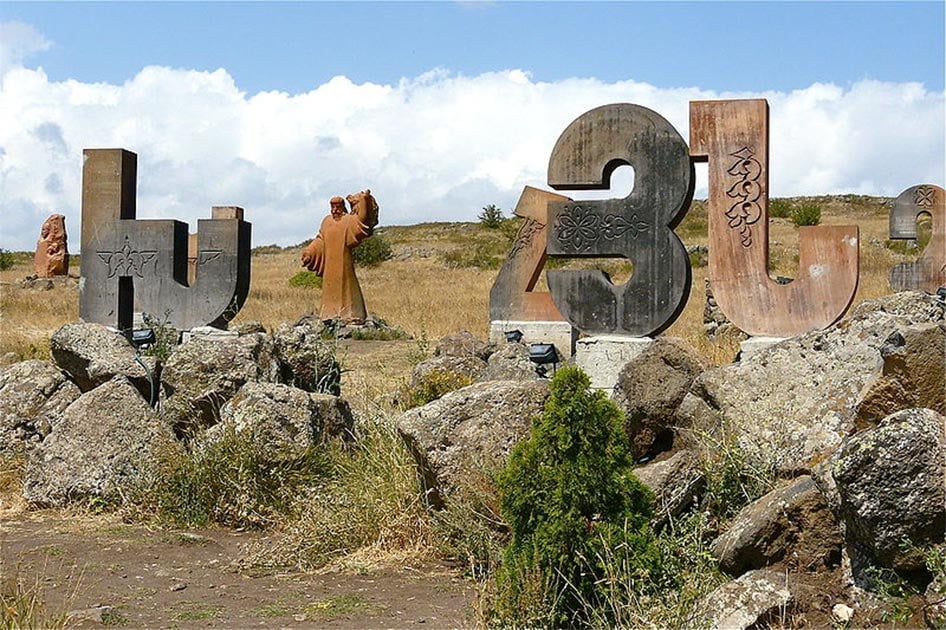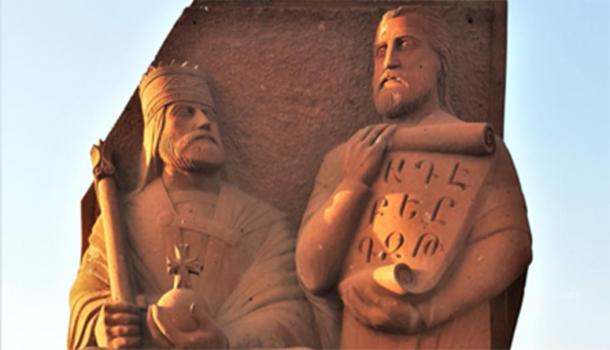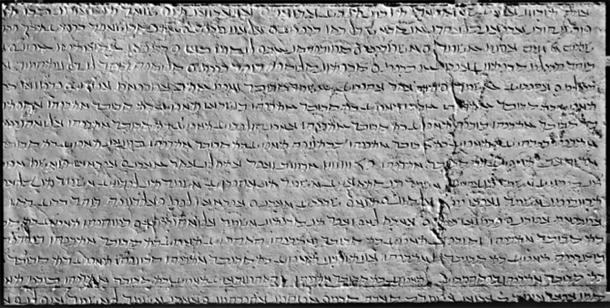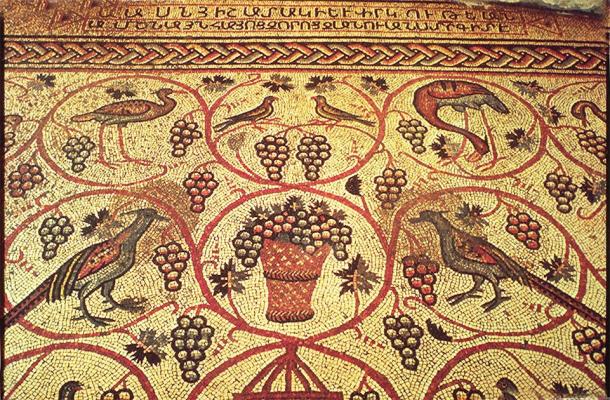The Armenian Alphabet, A Vision From God
 The Armenian alphabet is the script developed for the writing of the Armenian language. This alphabetic writing system was developed during the 5th century AD and is still in use today.
The Armenian alphabet is the script developed for the writing of the Armenian language. This alphabetic writing system was developed during the 5th century AD and is still in use today.
The Armenian alphabet not only allowed the Armenian language to be written, but also played a crucial role in the preservation of the national identity of the Armenian people. The Armenians continue to place great importance on their alphabet, and this is visible in the Armenian Alphabet Monument, which was erected in Byurakan in 2005.
Unlike the Latin alphabet, that most people are familiar with, the Armenian alphabet contains 39 letters. When the alphabet was first created it contained 36 letters, 7 of which are vowels and the other 29 consonants.
Three more letters were added later on, resulting in the Armenian alphabet having 39 letters. These three letters were added in order to facilitate the writing of translations. It may be added that each of the original letters have a numerical value, which meant that the alphabet could be used for mathematical calculations and for the recording of calendar dates as well.
While written Armenian remained more or less unchanged since the creation of its alphabet, spoken Armenian had split into two distinct dialects by the 19 th century, i.e. Eastern and Western Armenian. The former was known also as ‘Armenian of Russia’, and is based on the dialects of Yerevan and Tbilisi, the capitals of Armenia and Georgia respectively, whereas the latter was known also as ‘Armenian of Turkey’ and is based on the dialect of the Armenian community in Istanbul.
The Armenian language itself predates its alphabet. Armenian is an Indo-European language, a family of languages that includes most of the languages of Europe, the Iranian Plateau, and northern India. It has been speculated that the Armenians may have arrived in the areas surrounding Lake Van, Sevan, and Urmia as early as the second half of the 2 nd millennium BC. By the middle of the following millennium, the Armenians had replaced the local Urartians.
Evidence for this can be found on the Behistun Inscription , which was commissioned by the Achaemenid ruler Darius I , known also as Darius the Great. On the inscription are the names ‘Armina’ and ‘Armaniya’, the earliest known reference to Armenia.

Armenia is mentioned on the Behistun Inscription. ( पाटलिपुत्र / Public Domain )
The Creation of the Armenian Alphabet
In the subsequent centuries, Armenia was mentioned by various ancient authors. It seems, however, that the Armenians did not create records of their own. Till this day, no document (be it stone inscriptions, manuscripts, or legends on coins) with Armenian letters dating to before the 5th century AD has been discovered. On the other hand, the existence of a pre-5th century AD Armenian script is attested to in the works of some ancient authors.
As an example, Philo of Alexandria, a Hellenistic Jewish philosopher who lived between the 1 st century BC and the 1 st century AD, wrote that On Animals was translated into Armenian. On Animals was a work by Metrodorus of Scepsis, a Greek philosopher and historian who lived between the 2 nd and 1 st centuries BC.
Metrodorus was also a close friend and court historian of the Armenian king, Tigranes the Great , so he would have been familiar with the Armenian alphabet. As another example, Hippolytus of Rome, a 3 rd century AD theologian, wrote that the Armenians were one of the nations that had their own distinct alphabet.
In any case, the Armenian alphabet is popularly thought to have only been invented during the 5th century AD. According to tradition, the alphabet was created in 405 AD by Saint Mesrop Mashtots, an Armenian monk, theologian, and linguist. Mesrop was born around 360 AD into a noble family.

Saint Mesrop Mashtots created the Armenian alphabet. (Taron Saharyan~commonswiki / Public Domain )
According to Koryun, one of Mesrop’s pupils and biographer, the saint was a polyglot, being fluent in a number of languages, including Greek, Persian, and Georgian. He is recorded to have studied Classical languages under Saint Nerses I, an Armenian patriarch. After his studies, Mesrop became a monk, around 395 AD, and was later ordained as a priest.
Mesrop founded several monasteries and spread Christianity to the remote areas of the country, where the people were still practicing Mazdaism, the religion that dominated Armenia prior to the coming of Christianity. Incidentally, Armenia is considered to be the first country to have adopted Christianity as its state religion, i.e. in 301 AD, during the reign of Tiridates III.
Although Armenia was already a Christian state by the time of Mesrop’s birth, it is likely that most of the population were only nominally Christians. Since they could not read the Bible, many Armenians had a limited understanding of their religion. In addition, there were no Bibles written in Armenian, since there was no writing system for the language.
Still, knowledge of Christianity could be transmitted orally to the general population by men like Mesrop, so the problem was not without a solution. In 387 AD, however, Armenia lost its independence, and was divided between the Byzantine and Sassanian Empires, the two superpowers of the region at that time. It was feared that the Armenians would lose their national identity, as a result of assimilation into either Byzantine or Sassanian society. Therefore, something had to be done to preserve the national identity of the Armenians.

Armenian manuscript, 5 th – 6 th century. The Armenian alphabet was created to preserve the Armenian culture. (Bogomolov.PL / Public Domain )
It was Mesrop who came up with a solution, i.e. the invention of the Armenian alphabet. The saint was supported in this endeavor by Vramshapuh, who appointed Mesrop as his chancellor.
Vramshapuh ruled Armenia from 389 AD to 414 AD as a Sassanian client king. Although Mesrop is traditionally credited with the ‘invention’ of the Armenian alphabet, it may perhaps be more appropriate to say that he ‘re-invented’ it, since, according to the ancient sources, Mesrop modified a much older Armenian script that had been lost, rather than created a completely new set of letters.
Was the Armenian Alphabet Recreated From a Lost Script?
One version of the story is provided by Koryun. The tale begins with Vramshapuh receiving news that a Syrian bishop by the name of Daniel made an unexpected discovery of a forgotten Armenian script. The king related the story to his chancellor, Mesrop, and Sahak Partev (known also as Isaac of Armenia), the Armenian patriarch at the time.

Statue of Vramshapuh and Mesrop Mashtots near the Armenian Alphabet Monument. (Yerevantsi / CC BY-SA 4.0
The two men realized the significance of the discovery and urged the king to find a way to bring the script back to Armenia. Therefore, Vramshapuh sent a man called Vahrij with a message to Habel, a priest and close friend of Daniel. When Habel received the king’s message, he went immediately to Daniel, obtained the script from his friend, and sent it to the king.
Koryun claims that the script reached Vramshapuh in the fifth year of his reign. After seeing the script, Mesrop and Sahak asked the king for some young children with whom they could experiment with the alphabet. Seeing that the experiments of the two men were a success, the king ordered the alphabet to be taught throughout the kingdom.
After two years of using the alphabet, however, Mesrop and Sahak realized that the letters were insufficient for the writing of the Armenian language. Therefore, the two men decided that the letters needed to be updated and modified.
As hard as they tried, however, Mesrop and Sahak were unable to accomplish this task. Finally, it was through divine intervention that a solution was found. According to Koryun, one day, Mesrop received a vision from God, who instructed and aided the saint in the modification of the ancient letters, thus creating the 36 letters of the Armenian alphabet.
Influences on the Armenian Alphabet
In Koryun’s tale, the Armenian alphabet was reinvented from an older script, which indicates that Mesrop did not pluck the letters out of thin air. Scholars have been speculating about what this ancient script may have been. One suggestion is that the Armenian alphabet was based on the Pahlavi script, which was used for the writing of Middle Persian languages.

Some sources believe Pahlavi script, shown here, inspired the Armenian alphabet. (PawełMM / Public Domain )
This script was derived from Aramaic and was used to write new Zoroastrian religious texts, as well as to translate the existing Avestan scriptures. Therefore, this script would have been used in Armenia in a religious context prior to the arrival of Christianity. The Armenian alphabet also shows the influence of Greek, which is not entirely surprising considering that it was one of the alphabets used to write Christian scripture.
The influence of Greek is also visible in the resemblance of certain Armenian letters to Greek ones (not only visually, but also in the letter / sound order), the presence of letters for vowels, and the direction of writing, i.e. from left to right. In addition, a Greek by the name of Rufanos is believed to have helped Mesrop and Sahak when they created the Armenian alphabet.
According to tradition, the first sentence written by Mesrop after the invention of the Armenian alphabet was “To know wisdom and instruction; to perceive the words of understanding”. These words are from the Old Testament Book of Proverbs. Indeed, the first thing that Mesrop did with the new alphabet was to translate the Bible into Armenian.
Thus, the first popular Armenian Bible, the so-called ‘Mesropian Bible’, was produced by 410 AD. The original copy of Mesrop’s translated bible seems to have not survived. The ‘oldest surviving example of the Armenian alphabet’ is a subject of debate, though there are several contenders for this title.
One of these, for instance, is the Armenian inscription on the ‘Armenian Bird Mosaic’. This mosaic was discovered in 1894 near the Damascus Gate and the Musrara Quarter, in Jerusalem. From its style and iconography, the mosaic has been dated to the 5 th / 6 th century AD. The Armenian inscription on the mosaic reads as follows:
“To the memory and redemption of all the Armenians, whose names are known only to God”.

Works like the Armenian Bird Mosaic were created after the development of the Armenian alphabet. (Vissarion / Public Domain )
Other mosaics with Armenian inscription dating to the same period have also been found in Jerusalem. Another contender is the so-called ‘Narses Cross’, a silver cross with a single red garnet set in a gold filigree at the center.
Like the ‘Armenian Bird Mosaic’, the ‘Narses Cross’ has been dated to the 5 th / 6 th century AD. The Armenian inscription, which is found along the perimeters of the cross, translates as follows:
“I Nerseh Koms p‘ar˙ sinful and unworthy made this holy redeeming cross for [the church of] Saint Step‘anos in the village of P‘ar˙akert for the remission of my sins and for the repose + of the souls of our fathers and ancestors and for the prosperity and peace of Armenian houses and our villages and the family of Xorxor˙unik‘.”
Returning to the story of Mesrop, the saint did not stop at the translation of the Bible. The next thing he did was to send scholars to Constantinople, Alexandria, and Rome to search for biblical and literary manuscripts. As one might expect, these were translated into Armenian.
Mesrop is credited with the writing of a collection of biblical commentaries, the translation of patristic works, and the construction of liturgical prayers and hymns on an eight-tone scale. In other words, it was Mesrop who laid the foundation for a national Armenian liturgy, which in turn served to preserve the national identity of the Armenians.

Mesrop translated the Biblical works into Armenian using the newly created Armenia alphabet. (Fæ / CC BY-SA 4.0 )
Needless to say, Mesrop is a highly revered figure in Armenia. He died in 440 AD and his body was taken to the village of Oshakan, in the Aragatsotn Province, not far from the town of Ashtarak. Three years after Mesrop was buried in Oshakan, a church was built over the saint’s grave. Appropriately, it was named Saint Mesrop Mashtots Church.
The church was damaged and renovated a number of times throughout its history, and the current structure dates to the 1870s. The church is a well-known pilgrimage site, thanks to the saint’s reputation.
The invention of the Armenian alphabet by Mesrop is still a source of great pride for the Armenians even today. This is clearly seen in the creation of the Armenian Alphabet Monument. The monument is essentially a group of 39 giant stone carvings, one for each of the 39 letters of the Armenian alphabet.
The monument was created by J. Torosyan, an architect, in 2005, on the occasion of the Armenian alphabet’s 1600 th birthday. The monument is situated in Byurakan, a village on the slopes of Mount Aragats. As it is located not far from Oshakan, it is a tribute not only to the Armenian alphabet, but also to Mesrop Mashtots, the man who created it.
Related Post
A shocking documentary proves that mermaids do exist
SHOCKING Revelation: Thuya, Mother of Queen Tiye, Was the Grandmother of Akhenaten and Tutankhamun—What Ancient Egyptian Secrets Did She Leave Behind?
Breaking News: Astonishing Discoveries at Karahan Tepe Confirm an Extraterrestrial Civilization is Hiding on Earth, and NO ONE Knows!
Breaking News: Researchers FINALLY Discover U.S. Navy Flight 19 After 75 Years Lost in the Bermuda Triangle!
NASA’s Secret Investigation: Uncovering the Astonishing Mystery of the UFO Crash on the Mountain!
Explosive UFO Docs LEAKED: Startling Proof That Aliens Ruled Ancient Egypt!